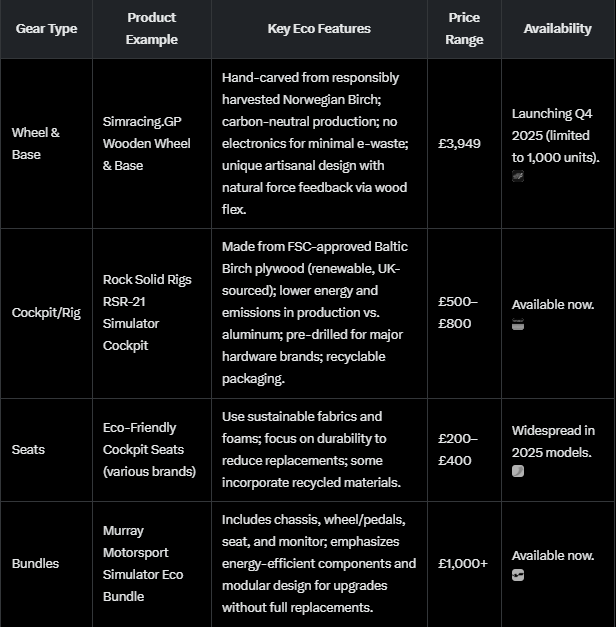Sustainable Sim Racing: Eco-Friendly Gear and Practices
In the fast-paced world of sim racing in 2025, where virtual tracks and high-octane competitions dominate, a quieter revolution is underway: sustainability. As the gaming and esports industries face increasing scrutiny over their environmental impact—from energy consumption to electronic waste—sim racers are turning to eco-friendly gear and practices to minimize their carbon footprint. Unlike traditional motorsports, which guzzle fuel and generate emissions, sim racing inherently offers a greener alternative by simulating real-world driving without the physical toll on the planet. According to industry insights, top motorsport organizations using simulators for 250,000 miles of virtual testing annually save 450 tons of CO2, £0.4 million in fuel, £8 million in tires, and £1.2 million in crash repairs compared to on-track equivalents. This article explores how you can make your sim racing setup more sustainable, from innovative hardware to everyday habits.
Why Sustainability Matters in Sim Racing
Sim racing's appeal lies in its accessibility and realism, but it's not immune to environmental concerns. High-end rigs often rely on power-hungry PCs, monitors, and peripherals, contributing to energy use and e-waste. However, the hobby's virtual nature positions it as a leader in green gaming. By replacing real-world testing with simulators, racers and teams drastically cut emissions—think reduced travel, fewer tire disposals, and no fuel burn. In 2025, trends like refurbished programs from brands such as Simucube emphasize circular economies, extending product lifecycles and reducing manufacturing demands. For events, sim racing stands out as a low-impact choice: setups require minimal power, produce no emissions, and use reusable equipment, making it ideal for corporate or community gatherings.
Broader industry shifts, including the adoption of biofuels and electric vehicles in real racing, are influencing sim ecosystems. Manufacturers are prioritizing sustainable materials like renewable woods over energy-intensive metals, aligning with global pushes for net-zero goals. As a sim racer, embracing these changes not only helps the environment but can also lower long-term costs through durable, efficient gear.
Eco-Friendly Hardware Options
The market in 2025 is seeing a surge in gear designed with sustainability in mind. Focus on products using renewable materials, low-energy designs, and ethical sourcing to cut down on waste and emissions. Here's a look at some standout options:
When selecting hardware, prioritize brands like
and Rock Solid Rigs for their commitment to renewables—wood requires less energy to produce than aluminum, which involves mining and high emissions. Refurbished options from established ecosystems (e.g., Fanatec or MOZA) also promote sustainability by reusing components, cutting new production needs. Look for certifications like FSC (Forest Stewardship Council) to ensure ethical sourcing.
Best Practices for Green Sim Racing
Beyond gear, sustainable sim racing is about mindful habits that amplify your setup's eco-benefits. Here are practical tips to integrate into your routine:
1. Optimize Energy Use: Power down your rig when not racing—PCs and monitors can consume significant electricity. Opt for energy-efficient hardware, like low-wattage GPUs or LED screens. For multi-hour sessions, consider solar-powered chargers for peripherals to offset grid reliance.
2. Reduce E-Waste: Choose modular, upgradable equipment to extend lifespan. When upgrading, sell or recycle old gear through programs like those from Simucube. Local sourcing minimizes transport emissions, as seen with UK-made wooden rigs.
3. Leverage Simulators for Real Impact: Use your setup to practice and reduce the need for real-world driving tests. This not only hones skills but slashes carbon outputs—virtual miles are emission-free.
4. Event and Community Focus: For leagues or meetups, host virtual events to cut travel. Promote reusable setups at physical gatherings, emphasizing low-power draws to avoid overloading circuits.
5. Maintenance and Longevity: Regularly clean and maintain your rig to prevent premature failures. Invest in durable materials like plywood over cheap plastics, which break down faster and add to landfills.
By adopting these practices, sim racers can contribute to broader sustainability goals, such as those in motorsports' shift to green tech.
Looking Ahead: The Green Horizon for Sim Racing
As 2025 progresses, expect more innovations like AI-driven energy optimization and bio-based materials in peripherals. Brands are increasingly focusing on eco-designs, with North American markets leading in energy-efficient hardware. Whether you're a casual hobbyist or competitive esports pro, sustainable sim racing isn't just a trend—it's a smart, future-proof way to enjoy the thrill of the track while protecting the planet. Start small: audit your current setup, swap in a green component, and race toward a cleaner tomorrow.

